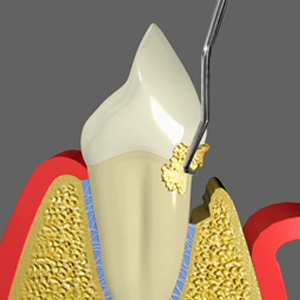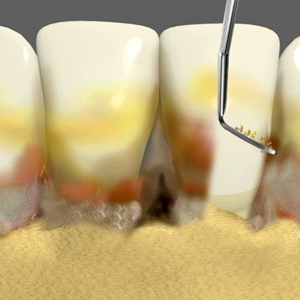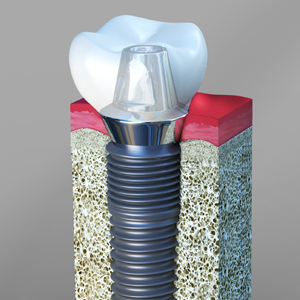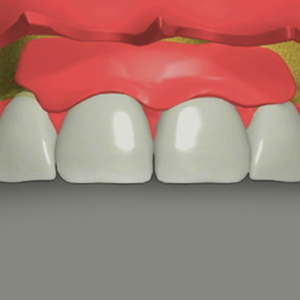Periodontal Care
Scaling and Root Planing or "Deep Cleaning"

Scaling and root planing, also known as deep cleaning, is performed to remove tarter and infectious bacteria from the surface of the teeth and roots. Dentists or hygienists use special tools to remove the tarter due to deep pockets or bone loss. This can help stabilize the bone and gum tissues that support the teeth. The intention is to stop the current disease process and to help prevent the disease from worsening. If left untreated, periodontal diseases can affect the stability of tooth roots and cause the teeth to eventually loosen, become infected, and possibly even fall out. The process of scaling and root planing is usually done in two visits and typically requires local anesthesia. This depends on the amount of tarter present over teeth and root surfaces. After the procedure is complete, patients should follow the post op instructions as well as the home care instructions provided by the dentist or hygienist. The best results require routine visits to keep the periodontal disease under control. Most patients with periodontal disease will require more frequent visits than other patients, typically every three to four months. A customized care regimen will be created for each patient individually which may consist of a combination of full mouth debridements, scaling and root planings, local antibiotic delivery, prescription mouthwashes and toothpastes, perio maintenance appointments every three or four months, and coronal polishing.
Periodontal Surgery

Periodontal surgery is performed when other less invasive procedures are not expected to improve the life of the gum tissues and teeth. In these cases, a referral to a periodontist may be necessary in order to control the factors that give rise to periodontal disease. There are several different types of periodontal surgeries that may also involve bone grafting or the use of a specialized laser. Patients with certain medical conditions like uncontrolled diabetes and cardiovascular disease may not be suitable for performing periodontal surgery.
Gummy Smile

Many studies have been done that quantify the so-called "ideal" smile. These studies have shown that the average human is able to visually detect even very minor imperfections in someone's smile, especially in what is called the esthetic zone by the dental community. The ideal smile exposes minimal gum tissues. In a gummy smile, more gum is visible which makes the smile seem less attractive. This problem may have several different causes such as high lip travel, excessive amount of gum that covers too much of the teeth, skeletal misalignment, etc. Because there are different causes, a gummy smile may be treated in several different ways. This usually involves a referral to a periodontist. A periodontist chooses a particular process based on the complexity of the condition and the underlying cause. Many cases involve crown lengthening or removal of excessive gum tissues. Laser treatment is one of the commonly performed procedures today. However, in more complex cases, surgical recontouring or lip repositioning may be necessary. In other cases, a referral to an oral surgeon may be necessary if the bone structures supporting the upper teeth are too tall which would require a different kind of surgery to correct. This entire process will start with a visit to your regular dental office for an evaluation. Once the most likely cause is identified, the appropriate referral will be made.
Dental Implants

When a tooth is lost the specialized bony process that houses the tooth begins to reabsorb. This causes a decrease in width and height of the bone in the area the tooth is lost. Neighboring teeth and opposing teeth begin to move into the space. This causes food traps, subsequent decay, gum disease and abnormal forces being transmitted to teeth leading to possible fractures which may necessitate root canal treatment or extraction. Loss of teeth can also cause the cheek and lips to collapse giving an aged look. Simply extracting a tooth does not usually eliminate the problem. In fact, it usually creates several more problems down the road!
The consequences of tooth loss can be prevented by replacing the lost tooth in a timely manner. Although there are several options to replace a missing tooth, the number one choice for replacing lost teeth are dental implants. Implants are tiny titanium screws or posts that are surgically placed in the bone. Once integrated into bone, they act like roots onto which small posts are attached which protrude through the gums. These posts provide stable anchors for crowns, bridges, denture attachments, etc. Implants maintain the bone height by stimulation and prevents unnecessary mutilation of adjacent teeth for bridge placement. Sometimes this trauma to the teeth created during the bridge prep results in more root canals which further adds to the expense. Since implants are titanium posts and are highly bio-compatible, there is no chance for dental decay on implants. Diligent home care is still required, however, in order to maintain the health of the tissues surrounding the implant or an infection may cause implant failure. Implants can service you for several years with regular professional cleaning and proper home care. They're the next best thing to your natural tooth!
Many people who are missing a single tooth opt for a fixed bridge, but a bridge may require significant cutting down of healthy, adjacent teeth that may or may not need to be restored in the future. Then there is the additional cost of possibly having to replace the bridge once, twice or more over the course of a lifetime due to decay or gum problems affecting the anchor teeth. The long term costs of a bridge versus an implant may be three or four times the overall cost of the initial implant. Remember, if an implant crown has to be replaced, it is usually a single crown replacement since the implant body itself is almost always still good. Replacement of a bridge is at least the cost of three crowns every single time!
Another option to replace missing teeth is a removable partial denture or complete denture depending on the number of teeth missing. The chewing efficiency with a denture is significantly reduced to more than half of that of natural teeth and typically only about 30% as efficient. The teeth that support the partial denture are weakened due to the excessive loads acting on them and many times are eventually lost. The denture rests on the gum causing tissue abrasion and possibly bone loss. Removable dentures may slip or cause embarrassing clicking sounds while eating or speaking.
Studies show that within five to seven years there is a failure rate of up to 30% in teeth located next to a fixed bridge or removable partial denture! This leads to even more costs for the patient.
Who is a candidate for implants?
Anyone who is missing one or several teeth is a candidate for implants. With the exception of growing children, dental implants are the solution of choice for almost all people of all ages, even those with the following health concerns:
Existing Medical Conditions: If you can have routine dental treatment, you can generally have an implant placed. While precautions are advisable for certain conditions, patients with such chronic diseases as high blood pressure and diabetes are still usually successful candidates for dental implant treatment.
Gum Disease or Problem Teeth: Almost all implants placed in patients who have lost their teeth to periodontal disease or decay have been successful. Global studies consistently show a 97% 10 year success rate!
Currently Wearing Partials or Dentures: Implants can replace removable bridges or dentures, or they can be used to stabilize and secure the denture, making it much more comfortable as well as significantly more efficient.
Smokers: Although smoking lowers the success rate of implants, it doesn't eliminate the possibility of getting them.
Bone Loss: Bone loss is not uncommon for people who have lost teeth or had periodontal disease. Your surgeon is trained and experienced in grafting bone to safely and permanently secure the implant.
Implant tooth replacement in children is usually deferred until their jaw growth is complete. A general rule of thumb says that the patient needs to be at least 16 years old. There are, however, some instances when a dental implant may be appropriate, such as when it is part of the child's orthodontic treatment plan. Your family dentist or orthodontist can guide you in this instance.
Procedure
Dental implant placement usually takes two surgical appointments:
- During the first surgical appointment the implant site is prepared to receive the implant following strict aseptic procedures. The selected size of the implant is placed in the prepared site. The gum tissue is then sutured over the implant. The implant takes 4- 6 months to fuse with the bone.
- During the second surgical appointment the implant is uncovered and the appropriate post is attached which will serve as the anchor for the replacement crown. An impression of the post is taken and sent to the lab for the precise fabrication of the implant crown. During this time a temporary crown may placed but not every time. Once the final crown is back it is either cemented with permanent cement or torqued into place with a tiny screw.
Gum Graft

Gum grafting is the process of surgically reconstructing or reshaping the gum tissues that results in taller or thicker gums. This may be necessary for cosmetic appearances, to aid in esthetic implant restorations, to treat extremely sensitive teeth from root exposure, to aid in esthetic crown and bridge placement, and for other disease related reasons. Sometimes this is needed to cover root surfaces of the teeth that have become exposed for various reasons. Root exposure may be due to gum recession or periodontal disease, for example. Recession due to disease may occur as a result of the accumulation of plaque and calculus over the root surfaces which gradually results in bone loss and possibly gum tissue destruction. When the gums start to become infected, the soft tissues tend to swell initially which traps even more debris and further plaque accumulation results in the formation of pockets. Recession from these causes almost always have a bacterial component. Other causes of root exposure may be due to a history of smokeless tobacco use, excessive or hard brushing, using a hard bristled tooth brush, or other habits which have worn away the gum tissues. In essence, gum grafting has both esthetic and medical advantages.
Request an Appointment
Our Reviews
I had a dental emergency and I was treated quickly and with great care. I am so impressed with the service of everyone. I can not thank you enough!
Leann CherryI’ve known Dr. Renfroe for many years and he is absolutely great! I highly recommend him and you should give him a call to set up your next appointment.
Will Canterbury
